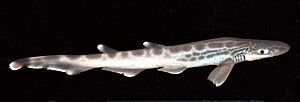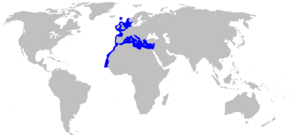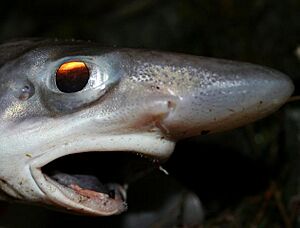Blackmouth catshark facts for kids
Quick facts for kids Blackmouth catshark |
|
|---|---|
 |
|
| Conservation status | |
| Scientific classification | |
| Genus: |
Galeus
|
| Species: |
melastomus
|
 |
|
| Range of the blackmouth catshark | |
| Synonyms | |
|
Pristiurus melanostomus Lowe, 1843 * ambiguous synonym |
|
The blackmouth catshark (Galeus melastomus) is a type of catshark. It belongs to the family called Scyliorhinidae. You can often find this shark in the northeastern Atlantic Ocean, from Iceland all the way to Senegal. It also lives in the Mediterranean Sea.
This shark usually lives deep in the ocean, on the continental slope. It prefers depths between 150 and 1,400 meters (about 490 to 4,600 feet). It likes muddy areas on or near the seafloor. Younger sharks tend to live in shallower waters than older ones. The blackmouth catshark has a slim body. Its mouth is black inside, which is how it got its name. Its back and tail have a marbled pattern of brownish spots with pale edges. It also has a special saw-toothed ridge along the top edge of its tail fin. These sharks can grow to be 50 to 79 centimeters (about 20 to 31 inches) long. Sharks in the Atlantic Ocean are usually bigger than those in the Mediterranean Sea.
Even though it swims slowly, the blackmouth catshark is an active hunter. It eats many different things, like crustaceans, cephalopods (like squid), and fish. It has excellent eyesight and can sense electricity, which helps it find prey that glows in the dark. This shark lays eggs, with females producing up to 13 egg cases at a time, all year long. Because there are so many of them, blackmouth catsharks are often caught by accident by deepwater fishing boats. They are not worth much money, so they are usually thrown back into the sea. However, the biggest ones might be sold for meat or leather. The International Union for Conservation of Nature (IUCN) says this shark is of "Least Concern". This means its numbers are not dropping, even with all the fishing.
Contents
What is a Blackmouth Catshark?
The blackmouth catshark was first described in 1810 by a scientist named Constantine Samuel Rafinesque. He noticed the unique black color inside its mouth. This is where the name melastomus comes from, which means "black mouth." Sometimes, people also call it the black-mouthed dogfish. Scientists have studied its DNA to understand how it is related to other sharks. They found that the blackmouth catshark is closely related to the mouse catshark. The oldest known fossils of this shark are from about 5.3 to 3.6 million years ago.
Where Do Blackmouth Catsharks Live?
The blackmouth catshark lives in a large area of the northeastern Atlantic Ocean. This includes places like southwestern Iceland, Norway, the Faroe Islands, and the British Isles. It also lives around the Azores and part of the Mid-Atlantic Ridge. You can find it all over the Mediterranean Sea, but not in the northern parts of the Adriatic Sea or Aegean Sea, and it is not in the Black Sea.
This shark mostly lives on the continental slope, which is the part of the seafloor that slopes down from the land. It is usually found at depths of 150 to 1,400 meters (about 490 to 4,600 feet). However, it has been seen in shallower water, as little as 20 meters (66 feet) deep in Norway. It has also been found in very deep water, up to 3,850 meters (12,630 feet) in the eastern Mediterranean. The exact depth where they are most common can change depending on the region. For example, they are often found at 300 to 500 meters (980 to 1,640 feet) in the Bay of Biscay.
Blackmouth catsharks prefer muddy areas on or near the bottom of the ocean. There is not much evidence that males and females live in different areas. Some studies suggest that adult sharks live deeper than younger sharks. However, other studies have not found this pattern. It is possible that some areas are good habitats for sharks of all ages.
What Does a Blackmouth Catshark Look Like?
Atlantic blackmouth catsharks can grow to about 67 to 79 centimeters (26 to 31 inches) long. Mediterranean sharks are a bit smaller, reaching 50 to 64 centimeters (20 to 25 inches). Females usually grow larger than males. The heaviest one ever recorded weighed about 1.4 kilograms (3.1 pounds).
This shark has a slim body and a long, pointed snout. Its nose has a flap that divides the nostril openings. Its eyes are oval-shaped and have a simple third eyelid for protection. There is a small hole called a spiracle behind each eye. The mouth is wide and has small grooves at the corners. It has many rows of tiny teeth, each with a main point and one or two smaller points on the sides. It has five pairs of gill slits.
The blackmouth catshark has two dorsal fins, which are about the same size and are located far back on its body. Its pectoral fins are large, while its pelvic fins are small. The anal fin is much bigger than the dorsal fins. The tail fin is about a quarter of the shark's total length. The top edge of the tail fin has a clear row of large, saw-like scales. The shark's skin is very thick and covered in small, hard scales called dermal denticles.
The body is grayish-brown on top, with 15 to 18 dark, rounded spots or blotches that extend onto its tail. Each dark mark has a lighter border. The underside of the shark is white, and the tips of its dorsal and tail fins are also white. The inside of its mouth is black, which is a key feature.
How Do Blackmouth Catsharks Live?
The blackmouth catshark is one of the most common sharks found on the upper and middle parts of the continental slope. It moves around a lot and can be found alone or in groups. This shark swims slowly, moving its body like an eel. It often swims just above the seafloor. This might help it save energy, similar to how an airplane wing gets a lift when close to the ground. It has also been seen resting still on the bottom. Other animals that hunt the blackmouth catshark include the kitefin shark and the European flying squid.
What Do Blackmouth Catsharks Eat?
The blackmouth catshark is an active hunter that eats many different kinds of food. It eats animals that live on the bottom of the ocean and those that swim freely. Its diet mainly includes decapods (like crabs and shrimp), krill, bony fish (such as lanternfishes), and cephalopods (like squid). The types of prey it eats most often usually depend on what is most available in its area. For example, it might eat certain types of shrimp off the coast of southern France.
Younger sharks eat more crustaceans than adults. Adults prefer larger fish and have even been known to eat other small sharks and rays, or even smaller blackmouth catsharks. Sometimes, scientists find parts of very large animals in their stomachs. This suggests that blackmouth catsharks might sometimes hunt in groups. They have also been seen eating leftover scraps.
When looking for food, the blackmouth catshark swings its head from side to side. This helps it use its senses better. It likely uses its eyesight and its ability to sense electricity (called electroreception) the most to find food. It probably relies less on its sense of smell. Its eyes are very good at seeing small or distant objects. The cells in its eyes are very sensitive to the light produced by glowing animals, which many of its prey create. For sensing electricity, the blackmouth catshark has many special sensors called ampullae of Lorenzini. These sensors are spread out evenly, which helps the shark find fast-moving prey very well.
How Do Blackmouth Catsharks Reproduce?
Unlike most sharks in its group, the blackmouth catshark can have many eggs growing at the same time. A female shark might have up to 13 eggs developing, but usually, it is 1 to 4 eggs in each of her two egg tubes. Scientists think a female can lay between 60 and 100 eggs each year, and larger females lay more eggs. Only the right ovary works in adult females.
The egg case is shaped like a vase. It has a small edge along the sides. The front end is square with two short, coiled horns at the corners. The back end is rounded. The egg case is a bit see-through, smooth, and shiny. When first laid, it is golden brown, but it turns dark brown in seawater. Egg cases from Atlantic sharks are bigger, measuring 3.5 to 6.5 centimeters (1.4 to 2.6 inches) long. Those from Mediterranean sharks are smaller, about 4.2 to 5.5 centimeters (1.7 to 2.2 inches) long.
Blackmouth catsharks mate and lay eggs all year round. They lay their eggs on muddy areas in shallower water. The size at which sharks become adults varies depending on where they live. Sharks in the Atlantic generally become adults at a larger size than those in the Mediterranean. Males become adults when they are about 48 to 79 centimeters (19 to 31 inches) long. Females become adults when they are about 39 to 79 centimeters (15 to 31 inches) long.
Blackmouth Catsharks and Humans
Blackmouth catsharks are not harmful to humans and are not very valuable for money. However, many of them are caught by accident by fishing boats that use bottom trawls (nets dragged along the bottom) and longlines (long lines with many hooks). They are one of the most common sharks caught by accident in nets that are trying to catch deepwater lobsters and shrimp.
Most of the sharks caught are thrown back into the sea, and many do not survive. Some fishing boats, especially off Portugal and Italy, keep a small number of the largest sharks. These are used for food (fresh or dried and salted) or for leather. For example, a fishing fleet in Italy reported catching 700 kilograms (1,500 pounds) of these sharks in 2005. In the northeastern Atlantic, more fishers are starting to target this shark as other deepwater shark species have become less common.
In some areas, like off Corsica and Sicily, most of the blackmouth catsharks caught are young. This suggests that fishing might be affecting their populations. However, the species is still very common in many places. Studies and fishing data have not shown that their overall numbers are declining. They live in a wide range of depths, which probably helps protect them from fishing. Also, a ban on trawling deeper than 1,000 meters (3,300 feet) in the Mediterranean helps protect them. Because of this, the International Union for Conservation of Nature (IUCN) has listed the blackmouth catshark as "Least Concern". This means they are not currently at high risk of extinction. In the waters of the European Commission, fishing for this shark is managed as part of the rules for deepwater sharks.




